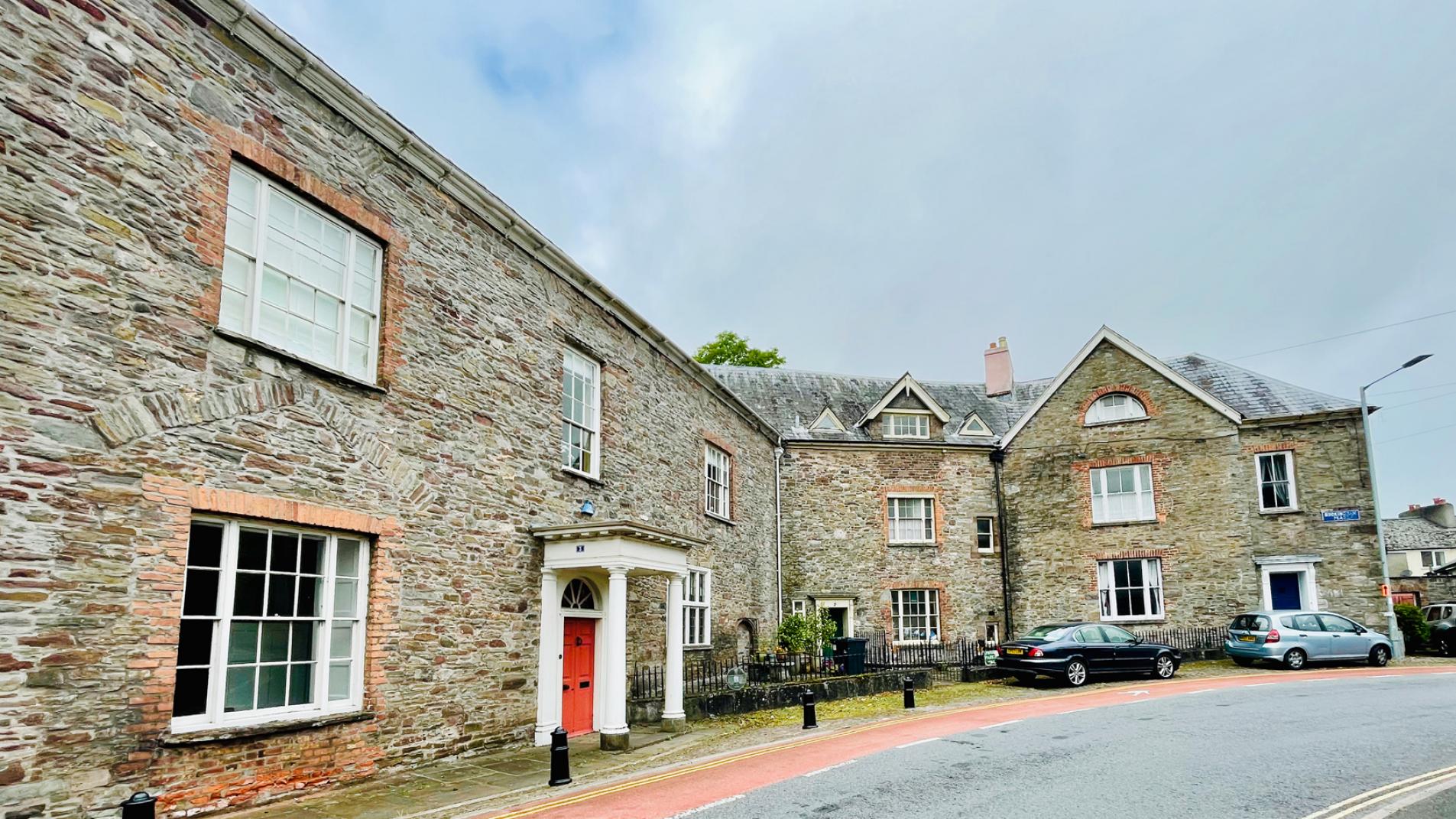
Visit historic buildings along Ship Street and Glamorgan Street. This is the 9th stop in WALK: The Brecon Story, our heritage trail around Brecon.
Watergate and Ship Street
Back on the town side of the bridge we are in Watergate, once the western entrance to the town. Brass studs in the road outside the Working Men’s Club mark the location of the original Water Gate entrance through the town wall. There were several pubs within a few yards of this spot. The Boar’s Head is still clear. Next door to the glass gallery was the Crown Inn. On the Working Men’s Club site stood the Fountain Inn, along Market Street was the Queen’s Head Hotel and the Black Lion Inn (on Castle Street but demolished to make way for the inner ring road). At the top of Ship Street was the Old Six Bells and around the corner from there, on Wheat Street, the Sun Inn, the Wheat Sheaf Inn (now the Rorke’s Drift) and behind that the Castle Brewery Pub.
Walking up Ship Street we have the ultimate mix of architectural history. On the right, the houses are mostly 17th century - some of the oldest in the town - but with updated frontages. On the left, the brick and glass of the former library opened by the King on 23rd July 1969, a few weeks after his investiture as Prince of Wales. It cost £115,000 and replaced a row of medieval buildings which opened directly onto Ship Street. The timber-framed 20 Ship Street gives a feel for what properties here may well have looked like. The Ovolo marking suggest and early to mid 17th century date with the frontage restored around 1970.
Wheat Street & Buckingham Place
Turning right at the top of Ship Street, we have the Coliseum Cinema, opened on Christmas Eve 1925. It was designed as a cinema but with facilities for live shows as well. It boasted seating for 800, 10 dressing rooms and and ‘a splendid stage, by far the biggest in the county…with space in front for a full orchestra.’ It replaced the ‘Electric Theatre’ Cinema which had also been in Wheat Street from at least 1913.
Some of the other grand houses in Wheat Street date back to the 17th century with 1-3 Buckingham Place the grand L shaped group at the end being even older - possibly 16th century - but with several later re-configurations. The remains of the medieval Lower water Gate is in the corner of their back garden which borders the Captain’s Walk. There are also Tudor windows making it the oldest domestic property in Brecon. The name ‘Buckingham Place’ only dates back as far as 1860, an historian of the time saying it was “conjectured’ that the Dukes of Buckingham had lived there previously. Church courts were sometimes held here during the period of the Commonwealth. John Chales Pratt, Earl of Brecknock was living here in 1866. Gwenllian Morgan(1852-1939), first woman mayor of a Welsh town lived here at the beginning of the last century and served as mayor in the Coronation year of 1911. She was often called Miss Philip Morgan - taking her father’s first name. She herself was part of an old Welsh family who traced their ancestry back to Brychan the Welsh prince who gave his name to Brycheiniog. As a keen historian she did much to shape our understanding of the town’s past - and research the life of the noted Brecon poet Henry Vaughan (1621-1695). She was also author of the first and many subsequent guide books to the cathedral.
Glamorgan Street
Passing Buckingham Place we come, on the right, to Havard House, the former Ursuline Convent. For much of the 20th century it was a Catholic girls school. It was also home, for many years, to another woman with a keen interest in Brecon’s history - and its theatres in particular - Sister Bonaventure Kelleher (1923-2019). It is a 17th century house with 18th century re-modelling. The museum has a lintel from the house dated 1619 and carrying the Havard crest. The house was owned by the Philips family from 1669. William Philips, was the Town Clerk and ‘a lover of antiquity’ his younger son, Captain Thomas Philips is the creator of The Captain’s Walk which follows the town wall to the rear of the house. Morgannwg House, next door is a grand early 19th century property that once formed part of the Convent school. It had a well laid out garden and even featured a fountain.
Boudica's Statue
Passing more grand houses, now turned into apartments, we turn right and walk across the car park, behind y Gaer to find a bronze statue commemorating Boudicca or Boadicea, the first century Queen of the Celtic Iceni tribe who led a revolt against the Romans. The statue shows Boudicca’s foot standing on a Roman shield, as her two daughters shelter at her side. It was created by the Gloucestershire Sculptor John Thomas in 1855. It once stood at the Elan Valley dam before being moved to Brecon in 1979 under the mistaken belief that it was cast by Brecon’s John Evan Thomas - creator of the Wellington statue that we saw in the Bulwark.
This is part of our WALK: The Brecon Story heritage trail. Click here to access the Google Earth map or visit the next place on our trail